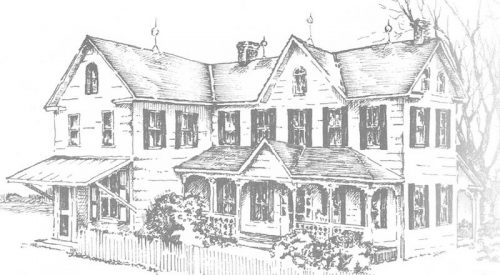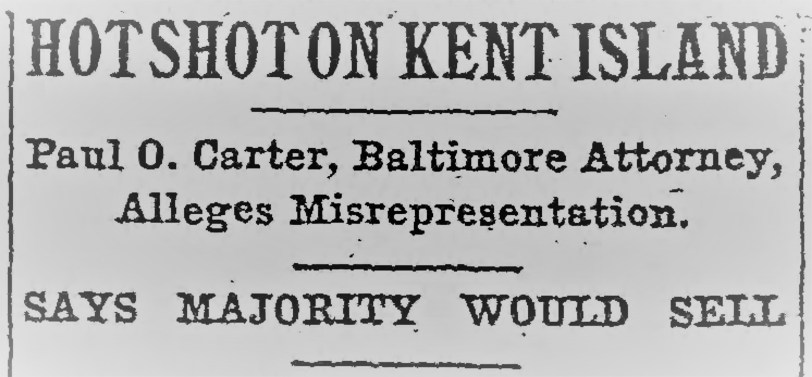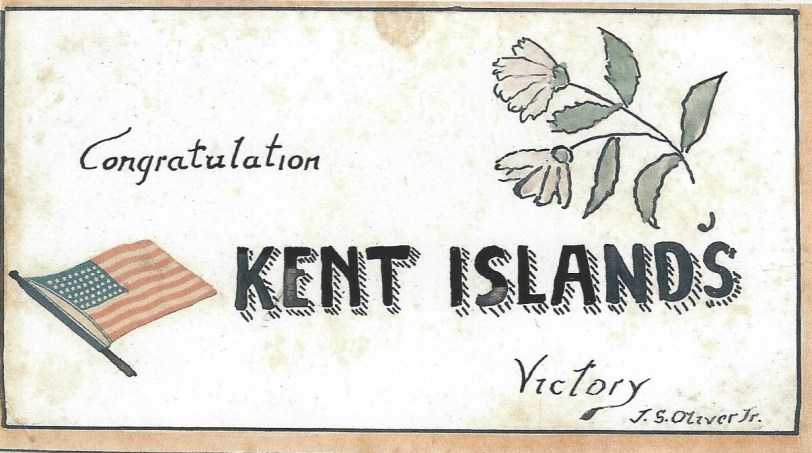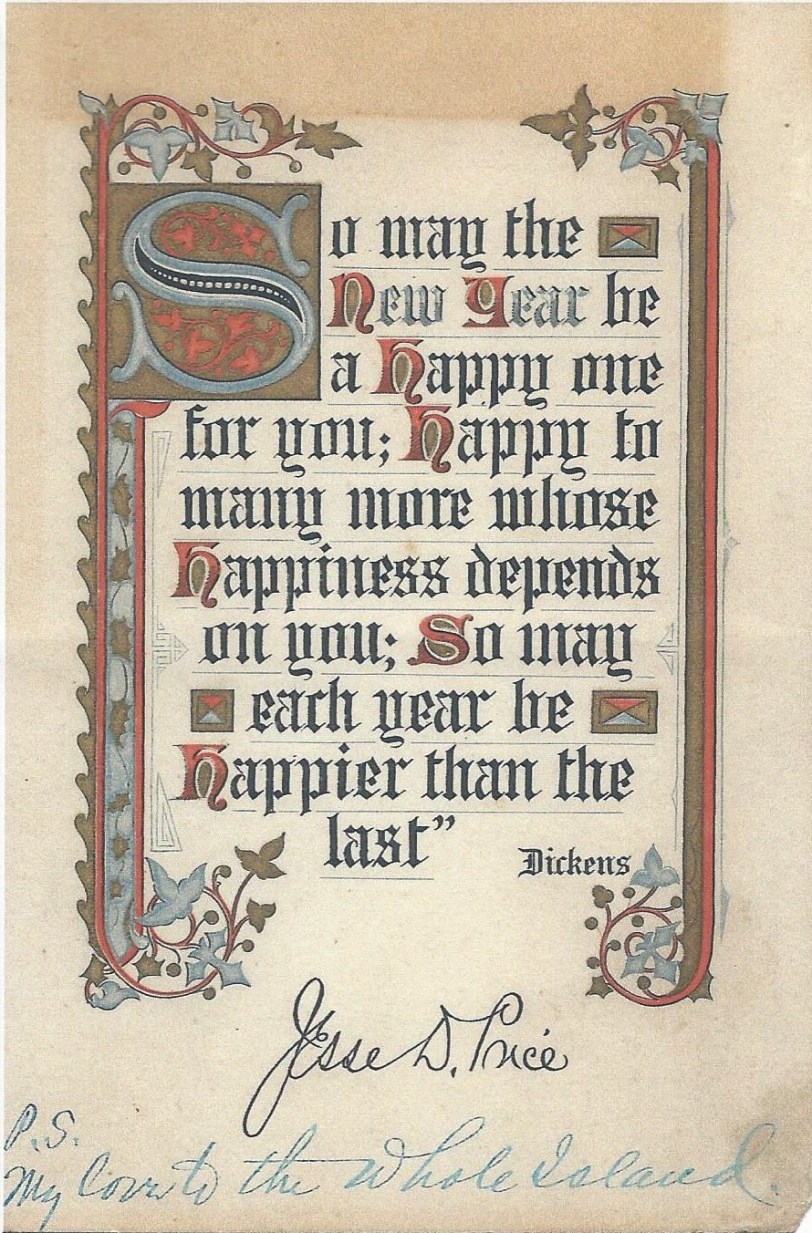 Courtesy of Kent Island Heritage Society
Courtesy of Kent Island Heritage Society
It was one hundred years ago.
1917.
The end of summer.
Kent Island, like most of the Chesapeake Bay’s Eastern Shore, was still very rural, its sparse population living in close-to-the-soil agricultural communities based around family farms and country stores, or in rough-and-tumble watermen’s enclaves.
Most people didn’t own a car, a telephone, or an indoor bathroom.
The average national annual income was less than $1,000 per year. One in a thousand marriages ended in divorce. Life expectancy was 48 for men and 51 for women.
Prohibition loomed.
War was consuming most of the world around us, and that past April, the United States had joined the fight, the Great War, the global conflagration that would become forever known as the First World War.
One hundred years ago. 1917. End of summer.
That’s when Kent Island went into battle against their own federal government.

The United States War Department was looking to build a proving ground to test the modern weaponry being developed to fight the war, and that summer, Kent Island was targeted, according to at least one account, by no less an authority than adviser Thomas Edison.
The Secretary of War, Newton D. Baker, determined that the almost the whole of the island, at least 19,000 acres, would be required if the plans were to be implemented, and out of the $3,000,000 the government had to spend, it was reported that 5,000 acres had already been optioned. If the deal went through, and the government threatened to exercise the right of condemnation and seize the island if it didn’t, 3,000 residents of the largest island in the Chesapeake would be displaced from their homes and livelihoods.
A group of Kent Island civic leaders met at retired Maryland State Senator James Kirwan’s store on July 3.
 Kirwan House and Store Courtesy of Kent Island Heritage Society
Kirwan House and Store Courtesy of Kent Island Heritage Society
One of the primary participants in the Island uprising, Henry Palmer, kept a diary of the subsequent events, and as befits a man representing residents of a community where so many made their lives from the land and water, Mr. Palmer’s entries all begin with a note on the day’s weather:
Wind-S. Date 3-Tues, The people of the island called a meeting to elect delegation of 5 to go to Washington to see Sect. Baker & try to get him not to take the island for proving grounds. Names of committee: W.E. Denny, Roland Carville, H. A. Palmer, J.R. Denton and James E. Kirwan.
Wind SW. Date 6-Fri, We went to Washington to see (Secretary of War Newton D.) Baker & (U.S. Senator from Maryland) John Walter Smith…we were cordially received and Sen Smith would have us take lunch with him and (we) stayed in Balt(imore) that night.
The Kent Islanders laid out their simple argument for choosing some other location:
Not only would the governmental takeover of their homeland create hardship for so many, but a significant portion of the local crab and oyster business would be destroyed, as would 250,000 bushels of grain, and acres of fruit, vegetable, and animal production.
The committee returned home on Saturday morning’s Love Point Ferry and held a public meeting that drew a “big crowd, according to Palmer.” Throughout July and August, while the committee continued to meet with various federal and state officials, including Maryland Governor Emerson Harrington, the debate roiled on.
 The Baltimore Sun
The Baltimore Sun
On August 4th The Baltimore Sun ran an article about “sharp correspondence” between members of the Maryland House Delegation when Delegate Paul O. Carter, a Baltimore lawyer from Kent Island, wrote that the Islander’s resistance to the War Department’s plans was doing a disservice to their state and their nation. Del. Carter questioned Kent Island’s patriotism and challenged the idea that most Islanders didn’t want to sell. Carter asserted that the island was far from the agricultural paradise it was claiming to be, that not enough corn was produced there to feed itself and the wheat was too poor to be graded. He stated that a majority of people who lived there had only moved there in the last half-century, and 50% of the population had arrived within the last 20 years, and with no ties to the “old families of this locality.”
Carter argued that the land was “mortgaged to the limit,” that a third of it’s population were merely Negroes, and that it “would be good thing to force the white people into other sections of the world, where new blood and energy could be injected into their children who were suffering from the effects of intermarriage. ”
Congressman Jesse D. Price replied: The Baltimore Sun
The Baltimore Sun
And in a letter written to The Sun, Kent Island Committee Member Sen. Kirwan disputed Del. Carter’s derogatory declarations toward the Island as “a batch of wholesale lies from beginning to end,” and that the island “was thoroughly ashamed that he (Carter) had spent the first three or four years of his life here.”
Del. Carter was not alone in his assessment of the Kent Islanders point of view. A cartoon in the Baltimore Sun lampooned what was seen by many as Kent Island’s crybaby ways: 
On Thursday , August 16th, a delegation of about 100 Kent Islanders traveled to Washington, and on Friday they, along with Congressman Price, went before the House Committee on Appropriations to make their case.
According to Mr. Henry Palmer, the wind was coming in from the south.

The Kent Island Committee of five were again in D.C. from Sunday, September 9th through Saturday the 15th, when they were joined by a delegation of 500 concerned citizens from the Eastern Shore. At a contentious hearing before the Senate Committee of Military Affairs, Sen.Smith and an Island representative, Dr. John R. Benton were scolded by Sec. Baker for resisting their country’s call during a time of war, and warned if seizure of the island were going to happen it would happen quick and soon.
From Henry Palmer’s Diary:
Wind – NE 16 – Sun. We (the committee) and the delegation all came back home on the early boat & no service at M.E. Church. Rev. G.S. Thomas in Washington.
 Courtesy of Kent Island Heritage Society
Courtesy of Kent Island Heritage Society
Wind – NE 17 – Mond. We (committee) went back to Washington & the military decided not to take K.I. as a proving ground about 3:15 PM & we at once telephoned the good news home to Kent Island and thanks to God.
The Baltimore Sun reported: “The senate Committee on Military Affairs, at a special meeting held that afternoon, had decided by unanimous vote that “neither Kent Island nor any part thereof should be taken by the government for a proving ground.”
Headlines from across the nation included the following:
The Washington Post announced:
NO PROVING SIGHT ON KENT ISLAND – SENATE COMMITTEE REJECT WAR DEPARTMENT PLAN.
The Morning Tulsa Daily World in Oklahoma:
KENT ISLAND SCHEME LOSES.
The Richmond, Virginia Times Dispatch:
KENT ISLAND WINS FIGHT TO BE LEFT IN PEACE.
Congressman Price sent the Kent Islanders a card of congratulations: 
 Courtesy of Kent Island Heritage Society
Courtesy of Kent Island Heritage Society
It was the end of summer.
1917.
One hundred years ago.
That’s when Kent Island won their war with the United States Government.
 Kent Island Day in May, 2017 celebrated the 100th year anniversary of their “Victory.”
Kent Island Day in May, 2017 celebrated the 100th year anniversary of their “Victory.”
HOPE TO SEE YOU AT THE 2ND ANNUAL CHESAPEAKE STORYTELLING FESTIVAL:
This is your best blog post ever! Thank you for sharing this. I had heard that the War Department had wanted to turn KI into a proving ground, but I didn’t know the details.
Thanks, Kenton!
Thank you for sharing this information. I did not know that they would post the weather before the letter. When it said about 100 people went to Washington my first thought was everyone on the Island went just about. I love to learn about our Island and the people on it. Thanks again. Very interesting.
Thank you so much for taking the time to comment! Glad you enjoyed, and hope you keep following easternshorebrent!
What a fantastic post!!
Thank you sir! Coming from a blogger I quite admire, that’s a much appreciate compliment!
I appreciate that, thank you.
Brent Another great one! How about a future blog about another history makimg action – the story of the ferry system(S). I always enjoy your writings, Jack Coursey
Glad you enjoyed, Jack! That’s a great idea! Being out of town, sorry we missed your birthday party!
great post, bfl ❤️
Thanks jct! hearts back at ya!
I am a new islander and former resident of Long Island, which did become a proving and training ground for the war.
I love this article which also represent the hardship of African American’s even in 1917. It is sad to think that he would use Kent Islands diverse population against us in his attempt to size our property. While the implication of his words I find very upsetting, it is letters like these that stand as markers that, although we cherish an agrarian culture, we were at the forefront on progress in regards to our population. For a people whose history before these time had been burned away it is refreshing to see where ancestors toiled
Thank you for taking the time to comment, James. I always try to include the African American experience in my writing, and agree that even in the context of the era, I cringe when I read such old-timey public displays of overt racism, but to me, saving these unpleasant parts of history say more about the true American experience than, at the risk of being too political, any Confederate statue might. Glad you enjoyed the piece, hope you check out some of my other work, and look in on easternshorebrent once i a while!
First, I apologize for the typos. Now that I have found you I will definitely keep up with your blogging. In regards to my comments, you will find that I am not a revisionist but I do spot things that help me understand our countries mindset and what demonstrates how far we have come. Thank you. Great work!
Amazing article. Thanks for sharing as I’ve only lived in QA Co 42 years and had no idea.
Thank you very much!Glad you enjoyed and hope you checked out some of the other posts on easternshorebrent!
This was such an interesting read,, and the very year my mother was born on Kent Island. Thanks.
Thank you, Julie! Glad you enjoyed. What is your mom’s name?
Thanks for the history lesson!
Thanks, Tony. Glad you enjoyed and hope you check out easternshorebrent every once in a while!
great read Brent keep up the historical facts Laura Keene
Thank you, Laura! Hope you and yours are well!
What a story!
Glad you enjoyed!
I don’t envy the public servants that have to make these tough decisions for the greater good. The sad thing is that if people gave up their homes to establish a Kent Island Proving Ground, at 19,000 acres, it would have been made quickly obsolete as the range of the weapons tested there increased. Even Aberdeen Proving Ground, that the people of Harford and Baltimore Counties gave up their homes for, at 72,320 acres, was becoming obsolete by the late 1950s, and was partly replaced by enormous facilities out West, including White Sands Missile Range in New Mexico.
Very interesting. Thank you for taking the time to comment!
Fascinating story! What a great share, thanks for posting.
Glad you enjoyed! Thank you for taking the time to comment!